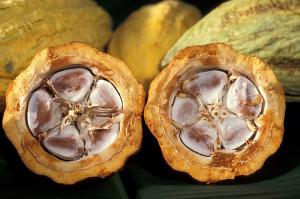Chocolatarians?
In Chocolate, More Cocoa Means Higher Antioxidant Capacity
Cocoa beans in a cacao pod.
(Photo by Keith Weller)
Cocoa powder contains more beneficial antioxidants than other chocolate products, but processing decreases their contents.
Those are the results of a study by Agricultural Research Service (ARS) scientists and their cooperators interested in the total antioxidant capacity (TAC) and procyanidin levels of six chocolate and cocoa products: natural (unsweetened) cocoa powders, Dutch processed (alkalinized) cocoa powders, unsweetened baking chocolates, semi-sweet chocolate baking chips, dark chocolates, and milk chocolates.
Chocolate and cocoa powder are derived from beans that contain hefty quantities of natural antioxidants called flavonoids. The researchers found natural cocoa contains the highest capacity of the antioxidant procyanidin. Antioxidants are thought to be effective in helping to prevent cancer, heart disease, and stroke.
Ronald L. Prior, an ARS nutritionist at the Arkansas Children's Nutrition Center (ACNC) in Little Rock, Ark., presented the study's results in San Diego, Calif., today with Liwei Gu and Xianli Wu of ACNC and Jim Harnly, a chemist at the ARS Beltsville (Md.) Human Nutrition Research Center. They presented the findings at Experimental Biology 2005, an annual meeting that brings together 16,000 biological and biomedical scientists from dozens of different disciplines.
The researchers found natural cocoa powders contained the highest levels of TAC and procyanidins, which were found to be the dominant antioxidant in chocolates. Milk chocolates, which contain the least amount of cocoa solids, had the lowest TAC and procyanidin levels. Baking chocolates contained fewer procyanidins, because they contained more fat (50-60 percent) than natural cocoa. Alkalinization, used to reduce the acidity and raise the pH of cocoa, such as Dutch chocolates, was found to markedly reduce procyanidin content. Researchers concluded that chocolates containing higher amounts of cocoa ingredients have higher procyanidin contents, therefore, higher antioxidant capacities.
Nine major manufacturers provided commercially available chocolate and cocoa samples and the National Institute of Standards and Technology provided its Standard Reference chocolate for analysis. The study was partially funded by a grant from the American Cocoa Research Institute.
ARS is the U.S. Department of Agriculture's chief scientific research agency.
Food of the gods?
Chocolate: history
Chocolate hotlinks
Stoned chocaholics?
Chocolate: food or drug?
PEA and antidepressants
Chocolate addiction and the brain
Does chocolate make babies happy?
Dark chocolate and the healthy heart
HOMERefs
HedWeb
Moodfoods
Future Opioids
BLTC Research
Utopian Surgery?
Supercentenarian.com
Some Chocolate Hotlinks
The Hedonistic Imperative
MDMA: Utopian Pharmacology
When Is It Best To Take Crack Cocaine?
The Good Drug Guide
The Responsible Parent's Guide
To Healthy Mood Boosters For All The Family

